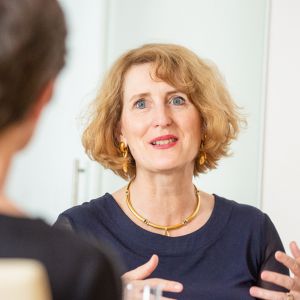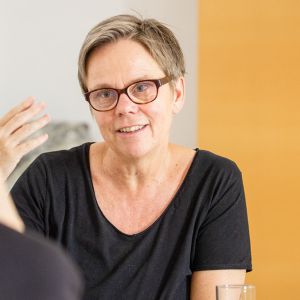Nach zwei Jahren intensiver Arbeit ist es so weit: Die Diversitätsstrategie der Universität ist fertig. Wie Vielfalt und Aufnahmeprüfung zusammenpassen, welche konkreten Maßnahmen nun geplant sind und was das alles der Universität bringen soll, erklären Rektorin Ulrike Sych und Vizerektorin Gerda Müller im Interview.
Kunst gilt als international, vielfältig und weltoffen. Warum braucht eine Universität für Musik und darstellende Kunst eine Diversitätsstrategie?
Gerda Müller (GM): Es gibt nicht nur eine Kunst, wir sprechen ganz bewusst von Musiken und Traditionen. Wir bilden für unterschiedlichste Bereiche aus: Wissenschaft, Pädagogik, Instrumentalstudium – um nur drei Beispiele zu nennen. Im Instrumentalstudium arbeiten wir mit verschiedenen Instrumenten und Repertoires. Um darstellen zu können, wofür unsere künstlerische Vielfalt steht, braucht es in unseren Augen eine Diversitätsstrategie.
Ulrike Sych (US): Ergänzen möchte ich noch den vielfältigen kulturellen Hintergrund unserer Studierenden und Lehrenden sowie die große Heterogenität unserer Studienprogramme. Als Musiktherapeut_in kommt man aus einem ganz anderen Bereich als Konzertpianist_innen oder Schauspieler_innen. Trotzdem haben alle ihren Platz an unserer Universität.

Kunst kann auch etwas Elitäres sein, mit dem man sich abgrenzen und über andere Gruppen erhöhen kann. Elite, Exzellenz und Diversität – wie passt das zusammen?
US: Wunderbar, das ist die perfekte Mischung. Wir verstehen Qualität sehr breit. Uns genügt es nicht, dass die Menschen in diesem Haus fachlich exzellent sind, bei uns kommt es auch auf die Haltung an. Die Wahrung der Rechte und Würde des Menschen ist bei uns nicht verhandelbar. Wer sich dieser Haltung nicht anschließen kann, wird sich hier nicht wohlfühlen.
GM: Wir haben uns zwei Jahre lang mit Ein- und Ausschlussmechanismen an der mdw auseinandergesetzt. Wer kommt zum Studium zu uns, wer bleibt draußen? 70 Prozent unserer Studierenden haben zumindest einen Elternteil mit einer akademischen Ausbildung. Zum Vergleich: An der Universität Wien sind es knapp unter 50 Prozent. Um den Zugang zu verbreitern, machen wir Projekte in Schulen mit u. a. hohem Migrationsanteil, Studierende der Pädagogik haben Geflüchteten Musikunterricht angeboten. Und: Wir versuchen, in der Ausbildung Diversität und Ungleichheit im Kontext von Exzellenz und Elite zu thematisieren.
Um an der mdw studieren zu können, muss man ein strenges Auswahlverfahren durchlaufen. Wie kann man vermeiden, dass dieses Nadelöhr zu einer „Vereinheitlichungsmaschine“ wird?
US: Ein Aufnahmeverfahren ist immer nur eine Momentaufnahme, das wird man auch mit zahlreichen zusätzlichen Kriterien nicht ändern können.
Gleichzeitig sehe ich, dass bei uns Menschen aus rund 70 Nationen studieren – diese kulturelle Vielfalt macht die Universität so stark. Ein Beispiel aus der Wissenschaft an der mdw: Die Ethnomusikologie an der mdw, deren Leiterin Ursula Hemetek letztes Jahr mit dem Wittgensteinpreis ausgezeichnet wurde, nimmt eine Vorreiterrolle ein. Mit der Ethnomusikologie, durch die Erforschung marginalisierter Gruppen und ihrer Musik, wurde ein neues Fach in der Minderheitenforschung geschaffen.
GM: Wir wollen den Aufnahmeprozess aber auch verändern: Zum einen überarbeiten wir das Informationsmaterial, achten auf Mehrsprachigkeit und Verständlichkeit. Die Menschen sollen zu uns finden, auch wenn sie noch keine persönlichen Kontakte zur Universität haben. Der Aufnahmeprozess soll für alle nach transparenten, nachvollziehbaren Kriterien ablaufen. Zum anderen wollen wir eine Checkbox mit alternativen Prüfungsmethoden anbieten.
Was kann man sich darunter vorstellen?
GM: Um ein Beispiel zu nennen: Wir haben blinde Interessent_innen. Wenn sie sich für eine Aufnahmeprüfung anmelden und die Checkbox anklicken, können wir alles vorbereiten. Es braucht z. B. anderes Notenmaterial, das auch blinde Menschen lesen können. Die Kommission sollte vorab informiert werden. Menschen mit körperlichen Einschränkungen brauchen Unterstützung auf dem Weg zum Prüfungsraum. Grundsätzlich möchten wir Prozesse etablieren, die garantieren, dass Menschen mit psychischen und physischen Beeinträchtigungen ebenso selbstverständlich zu einer Prüfung bei uns antreten können wie Menschen ohne Einschränkungen.
Dafür braucht es aber auch die Offenheit der Prüfer_innen …
GM: Absolut. Deshalb wollen wir die Selbstreflexion der Lehrenden stärken: Was passiert in einem Zulassungssetting? Worauf schaue ich? Wir haben schon vor Längerem eine hausinterne Studie zu den Bewertungskriterien künstlerischer Leistung beauftragt. Die Soziologin Rosa Reitsamer und ihr Team haben Klassenabende gefilmt und mit den Lehrenden besprochen. Dadurch sollen die Lehrenden ihr eigenes Mindset besser verstehen und im kritischen Hinterfragen ihrer eigenen Vorgangsweise unterstützt werden.
Diversität wird immer auch mit Internationalität in Verbindung gebracht – welche Rolle spielt sie in der Strategie der mdw?

GM: Sie stand auch immer im Mittelpunkt aller Überlegungen – egal, ob zum Curriculum, zur Zulassung oder zur Begleitung internationaler Studierender. Wir haben über 45 Prozent ausländische Studierende und möchten sie beim Ankommen in Wien noch stärker unterstützen. Unsere Idee ist ein Buddy-System: Wir bilden Tandems, höhersemestrige Studierende begleiten ausländische Kolleg_innen in den ersten sieben Monaten in Wien – beim Einstieg in den Studienalltag, bei der Wohnungssuche und Behördenwegen ebenso wie beim Einfinden in die Stadt, etwa was Ausgehen und Lokale betrifft.
Welche konkreten Maßnahmen planen Sie noch?
GM: Die Themen Gender und Diversität sollen in allen Lehrplänen verankert werden. Es wird auch einen Leitfaden zu gender- und diversitätssensibler Lehre geben. Und als fünfte Maßnahme wollen wir den Frauenanteil der Professor_innenschaft steigern. Für Wissenschaftlerinnen wird es Mentoring und finanzielle Unterstützung für beispielsweise Kongresse oder Übersetzungsleistungen geben. Bei den Künstlerinnen setzen wir auch bereits im Studium mit Karrieregesprächen an.
Was haben Sie denn durch den Strategieprozess gelernt?
GM: Ich habe einen neuen Blick auf die mdw gewonnen, die Organisation in so vielen Facetten kennengelernt – dieser Mehrwert ist unbezahlbar.
Das klingt so, als würde die ganze Universität an einem Strang ziehen – gibt es denn niemanden, der sagt: „Das brauchen wir alles nicht?“
GM: Solche Stimmen gibt es hundertprozentig. Manche haben schlicht bestritten, dass es an der mdw irgendeine Form von Diskriminierung gibt. Aber das Ergebnis zeigt: Es war die Anstrengung wert, Diversität aus der Position einer exzellenten Organisation zu analysieren.
Wenn Sie vorausschauen – was soll in fünf, zehn Jahren an der Universität anders sein aufgrund dieser Diversitätsstrategie?
US: Gleichbehandlung und Diversität müssen so selbstverständlich sein, dass man sie nicht mehr extra diskutieren muss. Ich wünsche mir aber auch, dass die mdw andere Kunstausbildungsstätten dazu anregt, es ihr gleich zu machen. Und über die Universität hinaus gedacht: Politisch betrachtet sollten Diversität, Transkulturalität und Gleichbehandlung als selbstverständlich betrachtet werden und daher in allen Parteiprogrammen enthalten sein.

